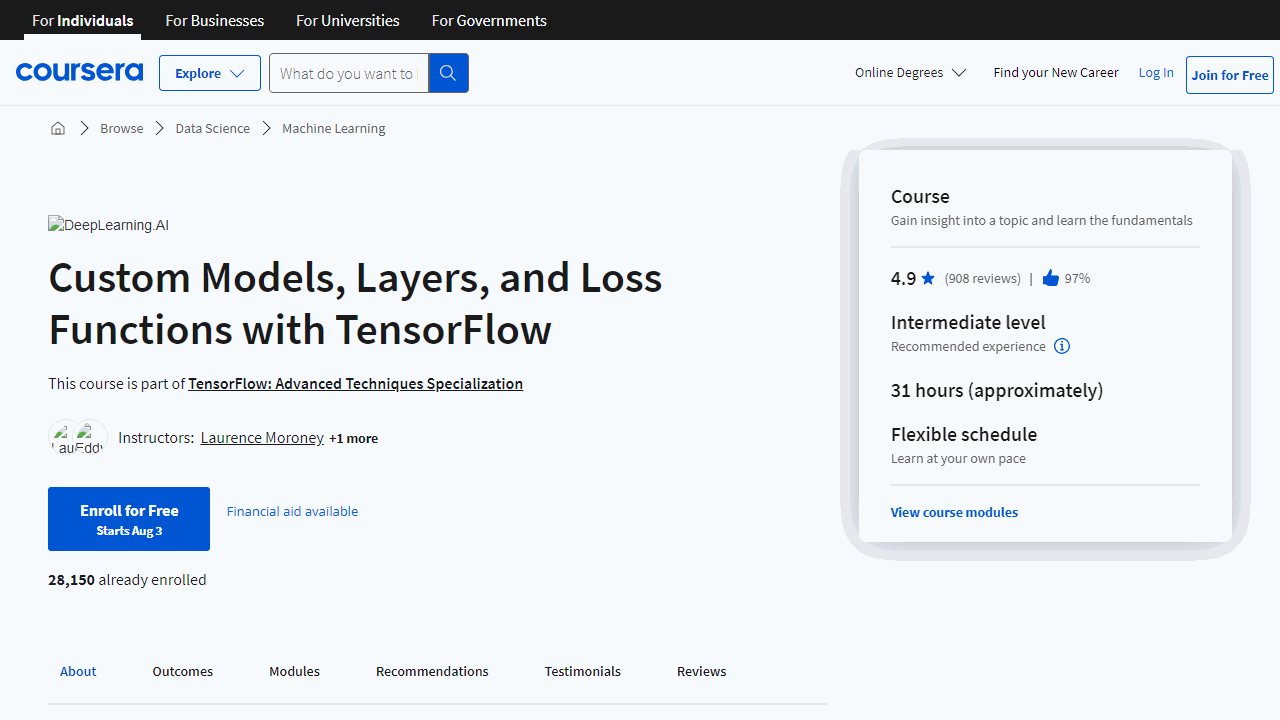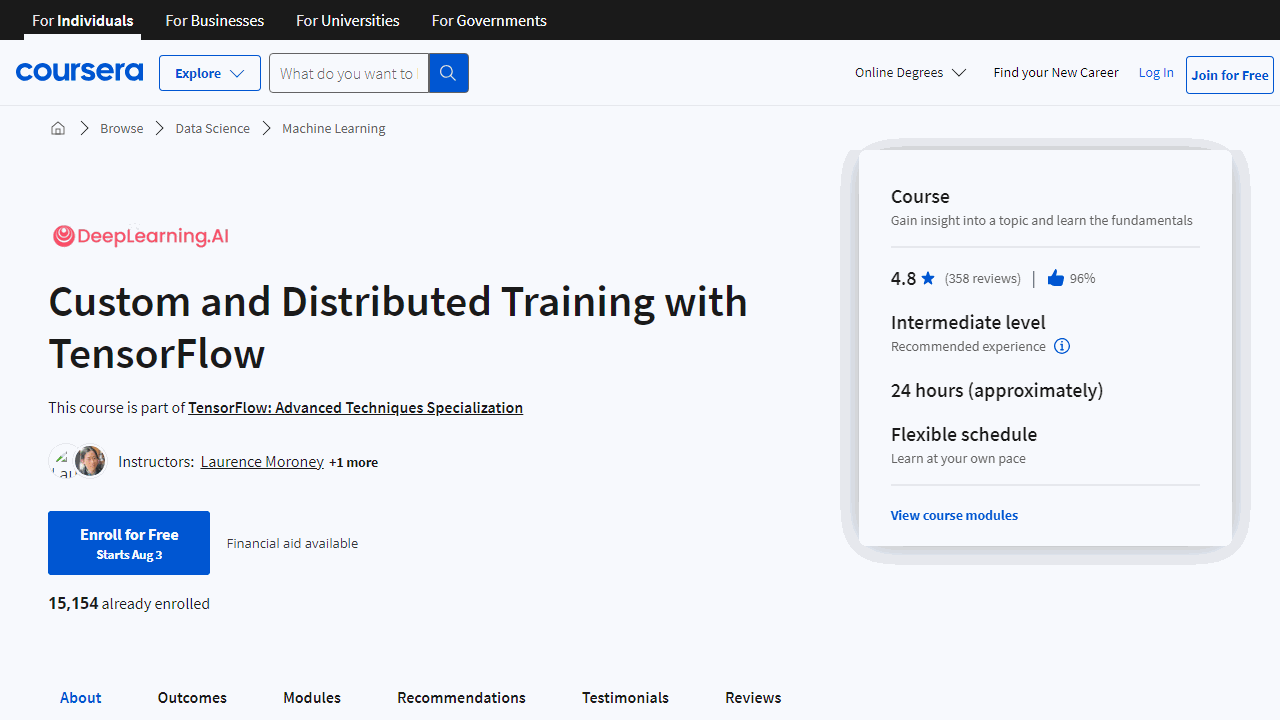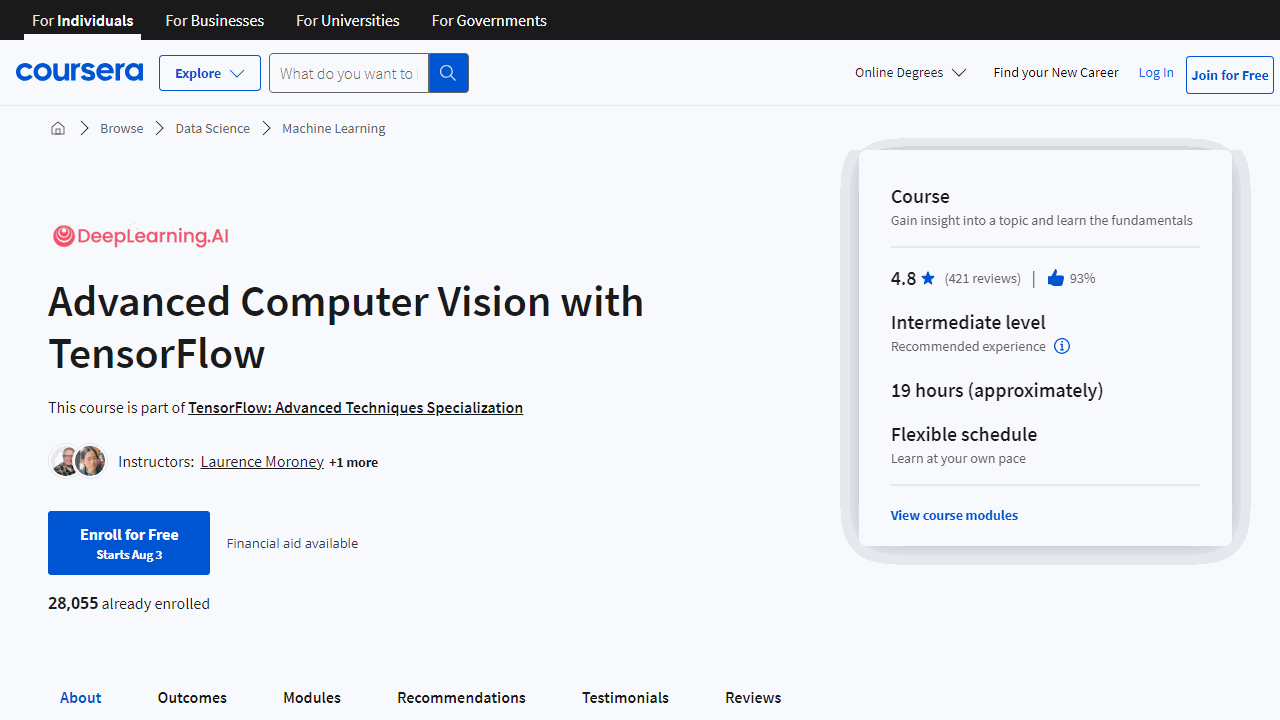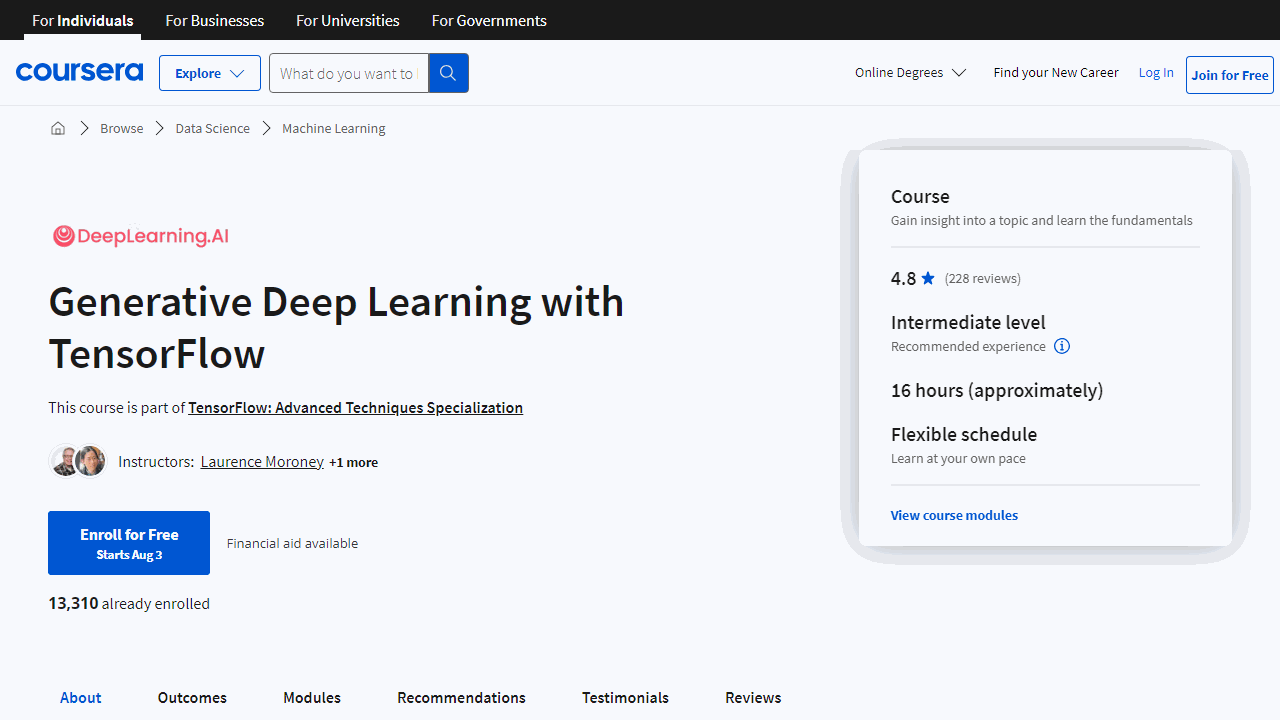- Rating: 4.8/5 with 1.219 ratings
- Provider: DeepLearning.AI
- Teacher: Laurence Moroney, Eddy Shyu
- Price: $49/month with a 7-day free trial
- Duration: Approx. 2 months if you study 10 hours per week (80 hours total)
- Pre-requisites: basic calculus, linear algebra, stats, knowledge of deep learning, experience with Python and a deep learning framework (e.g., TensorFlow, Keras, PyTorch)
- Level: Intermediate
- Certificate: Yes
- Coursera Plus: No
Deepening your understanding of TensorFlow and its advanced techniques can feel like a daunting task.
You might have a basic understanding of this powerful tool from previous deep learning courses, but when it comes to the more complex functionalities, things can get a bit tricky.
This is a common problem many individuals face when trying to expand their knowledge and skills in TensorFlow.
But don’t worry, I’ve got you covered!
In this article, I’ll introduce you to a series of courses offered by DeepLearning.AI on Coursera.
These courses are designed to guide you through the intricate world of TensorFlow, from custom models and layers to advanced computer vision techniques.
By the end of these courses, not only will you have a deeper understanding of TensorFlow, but you’ll also be able to apply these advanced techniques in practical scenarios, boosting your skills and confidence.
Let’s dive in and explore these courses together!
Custom Models, Layers, and Loss Functions with TensorFlow
- Rating: 4.9/5 with 908 ratings
- Duration: Approx. 18 hours
Diving deep into the world of TensorFlow, the course “Custom Models, Layers, and Loss Functions with TensorFlow” offers the first steps in your exploration of advanced functionalities.
The syllabus reveals a well-structured journey that begins with a clear overview of the course.
The first stop is the Functional APIs - an advanced technique offering model architecture flexibility. You’ll learn to declare and stack layers, create branching models, and even build multi-output models.
Next, you’ll explore the realm of custom loss functions.
The course guides you through the Huber Loss function and Contrastive Loss, equipping you with the skills to code these functions.
You’ll also learn how to add hyperparameters and transform these functions into classes, enhancing your practical understanding.
A major highlight of this course is the in-depth exploration of custom layers.
Starting with an introduction to Lambda Layers, you’ll experiment with custom Relu and even code your own custom Dense Layer.
This hands-on experience solidifies your understanding of a custom layer’s architecture and its role in training a neural network.
The final leg of your journey takes you to custom models.
You’ll encounter complex architectures with the Functional API, Wide and Deep models, and Residual networks.
Plus, you’ll get the chance to code a Residual network with the Model class.
Many students appreciate this course’s deep dive into model architecture and the accessibility of advanced TensorFlow functionalities.
One student shared how the course illuminated the flexibility of TensorFlow/Keras, unlocking new possibilities for him.
However, a few students felt that the course could have provided more real-world examples and deeper insights into certain topics.
Some also mentioned that the course was shorter than expected, which could be a bonus if you’re looking for a concise, time-efficient course.
If you’re ready to level up your TensorFlow skills and build more flexible models, this course is worth taking.
What You Will Learn
- Understand the Functional APIs in TensorFlow and how to use them for creating complex models.
- Learn how to declare and stack layers in a neural network model.
- Gain knowledge on creating multi-output and multi-input models, including Siamese networks.
- Develop skills in creating custom loss functions, including the Huber Loss function and Contrastive Loss.
- Discover how to add hyperparameters to custom loss functions and turn loss functions into classes.
- Explore the creation of custom layers, including Lambda Layers and custom Dense Layers.
- Learn how to train a neural network with custom layers and activate these layers.
- Understand the concept of custom models and how to code complex architectures like Wide and Deep models.
- Gain insights into the Model class in TensorFlow and how it simplifies architectures.
- Learn about built-in Callbacks and how to create custom Callbacks in TensorFlow.
Custom and Distributed Training with TensorFlow
- Rating: 4.8/5 with 358 ratings
- Duration: Approx. 14 hours
This course is meticulously detailed, ensuring you grasp the nuances of distributed training and custom training loops.
Many students have lauded the course’s ability to simplify complex concepts.
It breaks down everything from the basics of tensors and gradient tape to advanced topics like graph mode, autograph implementation, and various distribution strategies.
This makes each lesson digestible, leading to a smoother learning experience.
One unique feature of this course is the recap at the start of each video.
These serve as a roadmap, connecting the dots between different concepts and giving you a clear understanding of the learning journey. This thoughtful approach elevates the course from good to great.
Practical application is another highlight of this course.
You’ll have the opportunity to work through notebook examples and optimize your code using GradientTape.
While some students felt there could be more hands-on exercises, the existing ones still provide a solid foundation for applying your newfound knowledge.
The course instructor, Laurence Moroney, is a standout.
His ability to explain complex concepts in simple language makes the course accessible to beginners and experienced coders alike.
What You Will Learn
- Understand the concept of a tensor and how to create tensors in code.
- Learn about mathematical operations with tensors and get a basic code walkthrough.
- Explore broadcasting, operator overloading, and compatibility with Numpy.
- Evaluate variables and learn how to change data types.
- Dive into Gradient Tape and its application in Gradient Descent.
- Understand how to calculate gradients on higher order functions.
- Learn about custom training loop steps, loss, and gradient descent.
- Define the training loop and validate the model with a training basics code walkthrough.
- Discover the benefits of graph mode and how to generate graph code.
- Learn about control dependencies and flows, loops, and tracing variables.
- Get introduced to distribution strategies and understand different types.
- Learn how to convert code to the Mirrored Strategy and its application in custom training.
- Explore distributed training strategies and their practical applications.
Advanced Computer Vision with TensorFlow
- Rating: 4.8/5 with 421 ratings
- Duration: Approx. 19 hours
If you’re keen on exploring the depths of advanced computer vision, this TensorFlow course is a perfect fit.
It’s not just a step up from previous courses in the specialization, but a leap into the world of convolutional neural networks.
This added complexity is what makes it more challenging, but it’s also what makes it incredibly rewarding.
The course starts with an introduction to classification and object detection, seamlessly transitioning into segmentation.
The instructors have a knack for breaking down complex concepts into digestible bits, making it easier to grasp sophisticated architectures like FCN, U-Net, and ResNet.
What sets this course apart is the balance between theory and practice.
You won’t just learn about concepts; you’ll actually apply them in practical exercises.
These exercises will help you load models and restore checkpoints from new models you find around the web.
This hands-on approach is especially beneficial if you try to write the code yourself after going through it.
One of the highlights of the course is the section on interpretation.
Here, you’ll delve into class activation maps, saliency, and GradCAM, learning not just how to build a neural network, but also how to visualize what it’s focusing on.
This unique aspect is a treasure that you won’t find in many similar courses.
The course also does a great job of guiding you through the practical implementation of different deep learning algorithms.
The final week might be a bit intense, but it’s a fulfilling challenge that you can certainly handle.
In a nutshell, this course is a well-structured journey through the world of computer vision.
It’s evident that the instructors have put a lot of thought into the course design, bringing to the forefront the most salient points.
If you’re considering a career or research in computer vision, this course is a great starting point.
What You Will Learn
- Explore the fundamentals of classification and object detection in computer vision.
- Understand the concept and importance of segmentation in image processing.
- Learn about transfer learning and its significance in machine learning models.
- Get hands-on experience with ResNet50, a pre-trained model, for transfer learning.
- Dive into the architecture of object localization networks and their evaluation methods.
- Discover the evolution of R-CNN, Fast R-CNN, and Faster R-CNN for object detection.
- Learn how to use TensorFlow Hub to get pre-trained models.
- Gain practical experience in running models on images and visualizing results.
- Understand the process of loading a RetinaNet Model and its weights.
- Get a comprehensive overview of image segmentation and its popular architectures.
- Learn about the FCN architecture and various upsampling methods.
- Write code for encoder and decoder in image segmentation.
- Evaluate segmentation models using Intersection over Union (IoU) and Dice Score.
- Understand the U-Net architecture and write code for its encoder and decoder.
- Learn about instance segmentation and its applications.
- Understand the importance of interpretation in machine learning models.
- Learn about Class Activation Maps and their implementation in Fashion MNIST.
- Understand the concept of saliency in computer vision.
- Learn about GradCAM and its role in visual explanations for Convolutional Neural Networks.
- Get introduced to ZFNet, a convolutional neural network that won the ImageNet Large Scale Visual Recognition Challenge in 2013.
Generative Deep Learning with TensorFlow
- Rating: 4.8/5 with 228 ratings
- Duration: Approx. 16 hours
“Generative Deep Learning with TensorFlow” is a highly recommended course that offers a solid grounding in advanced deep learning concepts.
The well-structured syllabus and clear explanations make the course a standout choice for those keen to delve into this area of study.
Starting with an introduction to style transfer, the course gives a clear conceptual overview and guides you through the pre-processing of inputs.
It then takes you through the extraction of style and content features, and the calculation of total and content loss.
The thorough yet concise presentation of complex topics is appreciated by many students.
The course then moves on to autoencoders, beginning with a basic model and gradually progressing to more complex structures.
An interesting highlight here is the focus on denoising with an autoencoder, a feature that sets this course apart from others.
As you move further into the course, you’ll explore Variational AutoEncoders (VAEs).
This section breaks down the architecture and code of VAEs, and provides clear explanations of the sampling layer and encoder, decoder, and loss function.
Students have particularly enjoyed this part of the course, finding it both engaging and informative.
The course wraps up with an introduction to Generative Adversarial Networks (GANs), covering everything from the first GAN architecture to the training loop, and even a face generator.
This hands-on section of the course allows you to apply your learning to build complex models from scratch.
The course has been praised for reinforcing learning through weekly quizzes and assignments, and for providing ample opportunities to gain practical experience with TensorFlow.
A few students suggested that the course could cover more generative methods and include a comparison of data generated from different models using the same dataset.
Despite this, the course’s focus on image processing does not limit its applicability, and the skills you learn can be transferred to other areas.
What You Will Learn
- Explore the concept of style transfer in deep learning and its application in TensorFlow.
- Understand the process of pre-processing inputs for generative deep learning models.
- Learn how to extract style and content features from images using deep learning techniques.
- Dive into the calculation of total loss and content loss in style transfer models.
- Discover the concept of style loss and its role in the overall loss calculation.
- Learn how to update the generated image in a style transfer model.
- Understand the concept of Gram Matrix and Einstein Notation in the context of deep learning.
- Explore the application of Fast Neural Style Transfer in TensorFlow.
- Learn how to build and train AutoEncoders, including MNIST AutoEncoder, Deep AutoEncoder, and Convolutional AutoEncoder.
- Understand the architecture and training process of Generative Adversarial Networks (GANs), including DCGANs and Face Generator.
Frequently Asked Questions
How Long Does It Take To Complete The TensorFlow: Advanced Techniques Specialization?
It’s estimated to take approximately 2 months to complete if you study around 10 hours per week.
This means the total duration of the specialization is roughly 80 hours.
However, the actual time it takes can vary depending on your prior knowledge, learning pace, and the amount of time you can dedicate to the courses each week.
How Much Does The TensorFlow: Advanced Techniques Specialization Cost?
The TensorFlow: Advanced Techniques Specialization on Coursera costs $49 per month.
This fee gives you access to all the course materials, graded assignments, and a certificate upon completion.
The specialization also offers a 7-day free trial, allowing you to explore the course content before committing to the monthly fee.
Please note that prices may vary depending on your location and any promotions Coursera may be running at the time.
Is The TensorFlow: Advanced Techniques Specialization Part Of Coursera Plus?
No. Coursera Plus subscribers do not have access to the TensorFlow: Advanced Techniques Specialization.
What Is The Difference Between A Coursera Course And A Specialization?
A Coursera course is a single, standalone module that focuses on a specific topic. It includes video lectures, readings, quizzes, and sometimes a final project or exam.
Once you complete a course, you receive a certificate of completion.
On the other hand, a Coursera Specialization is a series of related courses designed to help you master a specific topic.
Specializations are structured to provide a deeper, more comprehensive understanding of a subject area.
They often culminate in a capstone project that allows you to apply what you’ve learned throughout the courses.
Once you complete all the courses in a Specialization, you receive a Specialization certificate.
So, the main difference is that a course is a single module on a specific topic, while a Specialization is a series of related courses designed to provide a comprehensive understanding of a broader subject area.
How To Get The TensorFlow: Advanced Techniques Specialization For Free?
Coursera offers financial aid for students who cannot afford the fee.
You can apply for financial aid by clicking on the “Financial aid available” link next to the “Enroll” button on the course page.
You’ll need to fill out an application and wait for approval, which can take up to 15 days.
Also, Coursera occasionally offers promotions or discounts, so it’s worth checking their website regularly.
Please note that while you may be able to access some course materials for free during a trial period, you typically need to pay for the course to receive a certificate.




